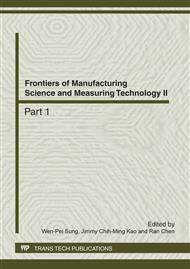p.863
p.867
p.872
p.876
p.880
p.884
p.888
p.892
p.896
Comparative Analysis of Parabolic and Hyperbolic Flexure Hinges Using Closed-Form Equations
Abstract:
The comparative analysis of a parabolic and hyperbolic flexible hinges were presented. The closed-form compliance equations in the working and non-working plane can be derived by using the Castigliano’s second theorem. In order to compare the relative performance of parabolic and hyperbolic flexure hinges, a ratio function between specific compliances of the two hinges is defined. We analyzed the non-dimensional ratios of working plane and non-working plane compliance to show the relative properties of parabolic versus hyperbolic flexure hinges. The analysis results has showed compared to a hyperbolic flexure, a parabolic flexure can produce more desired output and is slightly less sensitive to axial effects under identical loading conditions. Meanwhile, the comparative study on the parabolic and hyperbolic flexure hinges can provide a theoretical basis for choosing them.
Info:
Periodical:
Pages:
880-883
Citation:
Online since:
April 2012
Authors:
Price:
Сopyright:
© 2012 Trans Tech Publications Ltd. All Rights Reserved
Share:
Citation:


